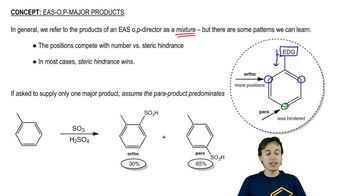b. Rank the same compounds from greatest tendency to least tendency to undergo electrophilic aromatic substitution.
chlorobenzene, 1-chloro-2,4-dinitrobenzene, p-chloronitrobenzene
 Verified step by step guidance
Verified step by step guidance Verified video answer for a similar problem:
Verified video answer for a similar problem:



 4:29m
4:29mMaster Activity and Directing Effects with a bite sized video explanation from Johnny
Start learning